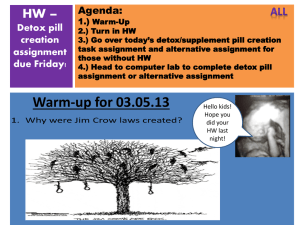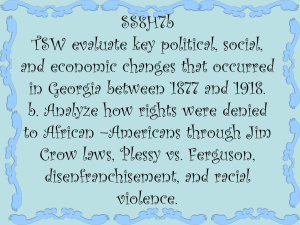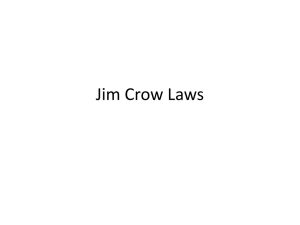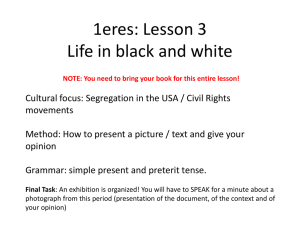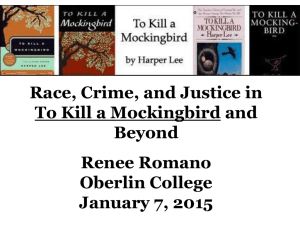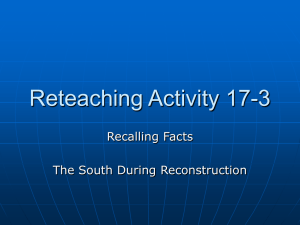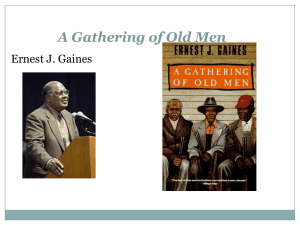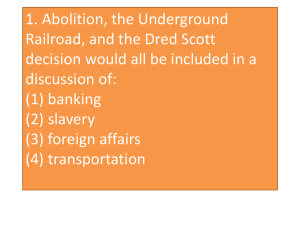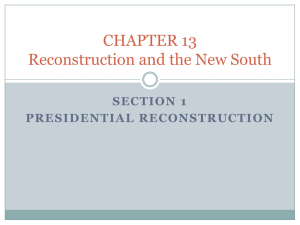Post- Reconstruction ppt.
advertisement
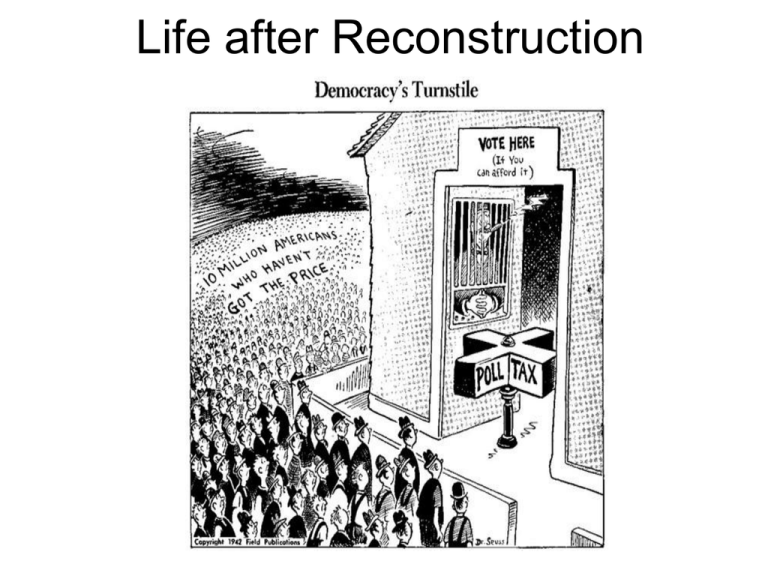
Life after Reconstruction After the Civil War: Blacks make political and civil gains… •13th Amendment - gave 4.3 million slaves their freedom •14th Amendment - African Americans given citizenship •15th Amendment - African American men given right to vote 2 African Americans Lost Economic Power •40 Acres & a Mule After slavery, many African Americans thought they would get this, but didn’t •Sharecropping Instead work on land owned by whites & share profits from crops 3 African Americans Lost Political Power •Poll Tax - had to pay to vote •Literacy Test - Had to read to vote •Grandfather Clause - Could get around 1st 2 if your grandfather could vote 4 1876 Presidential Tickets The Presidential Nominees of 1876 • Election of 1876 was controversial and disputed. • Republican nominee Rutherford B. Hayes and Democratic nominee Samuel Tilden. • Tilden, the Governor from New York was nominated in St. Louis alongside Indiana Governor Thomas Hendricks • Rutherford B. Hayes, Governor of Ohio, and a former Congressman was nominated for the presidency by the Republican party in Cincinnati at the Republican National Convention, with New York Congressman William Wheeler nominated as his running mate. Campaign Slander • Campaign slander was widespread, with slur tactics used in order to boost support for opposing candidates. The Initial Outcome • It appeared initially as November 7th came to a close that Tilden was winning the Electoral College vote with 184 electoral votes to Hayes' 165. • The popular vote too appeared to favor Tilden with 51% or 4,284,020 for the Democratic candidate, while Hayes received 48% of the popular vote, or 4,036,572. The Contested Results • The Electoral vote, 184 for Tilden and 165 for Hayes, and 20 electoral votes in dispute. • Three southern states, South Carolina with 7 electoral votes, Florida with 4, and Louisiana with 8, as well as Oregon (with only one of the three electoral votes contested) were contesting the results of their electoral vote. Political Cartoons • The disputed election resulted in numerous political cartoons dedicated to the crisis. • The cartoon entitled "A National Game That is Played Out" represents the discontent of the cartoonist over the apparent gamy nature the disputed election was being handled. • “Compromise Indeed!" represents the perceived bullying on the part of the Democrats in their plight. The popular press was particularly critical of the Democratic effort to get Tilden elected. • "A Jewel Among Swine", presents a rather scathing view of the electoral boards of the disputed southern states, in this case Louisiana. Election Violence and the Red Shirts • Violence and pressure occurred during the election particularly by the supposed Red Shirts of South Carolina. • These staunch southern Democrats were known for their bullying and intimidation of African American voters. • Accusations claimed the Red Shirts were both forcing African Americans to vote democrat, and even preventing them from voting altogether. A Final Outcome • On March 2, 1877, Rutherford B. Hayes was declared President of the United States, bringing an end to the four month debate, he won by ONE vote. • Three days later, on March 5, Hayes was sworn in as President. The Compromise of 1877 • The Compromise of 1877 is often perceived as the end of Reconstruction. • Pulled federal troops out of state politics in the South, and ended the Reconstruction Era. • Through the Compromise, Republican Rutherford B. Hayes was awarded the White House over Democrat Samuel J. Tilden on the understanding that Hayes would remove the federal troops whose support was essential for the survival of Republican state governments in South Carolina, Florida and Louisiana. • The following map portrays the Reconstruction military redistricting of the south which came to an end with the Compromise of 1877 SEGREGATION AND DISCRIMINATION • By the turn of the 20th century, Southern States had adopted a broad system of legal discrimination • Blacks had to deal with voting restrictions, Jim Crow laws, Supreme Court set-backs, and physical violence WHAT IS DISCRIMINATION? • Discrimination involves: • Beliefs : "This group of people is inferior because" • Emotions : "I hate this group of people." • Actions : "I will deny opportunity/hurt/kill members of this group." What is Racial Segregation? It is the separation of a certain group of people, based on their race, from another group in daily life. http://en.wikipedia.org/wiki/Racial_segregation • Black Codes- U.S. States passed these laws to take away the Civil Rights of African Americans. » Occurred in former Confederate States in the 1860s and the laws went on a state by state basis » Examples of Black Codes: Literacy Tests to vote Licenses required for work, marriage, weapons, property ownership, etc. NO Vagrancy, required to work, and the Codes regulated the type of work, and the hours of labor VOTING RESTRICTIONS • All Southern states imposed new voting restrictions and denied legal equality to African Americans • Some states limited the vote to those who could read, other states had a poll tax which had to be paid prior to voting Racial Segregation • January 1, 1863: Lincoln issued the Emancipation Proclamation, which declared freedom for all slaves. – Intended to weaken the South’s power during the U.S. Civil War – Although slaves were “free,” black people were affected by state laws that prevented equality – These laws were known as the Jim Crow Laws Jim Crow Laws • The term Jim Crow comes from the minstrel show song “Jump Jim Crow” written in 1828 and performed by Thomas Dartmouth “Daddy” Rice, a white English migrant to the U.S. and the first to popularize the blackface performance. • A caricature of a shabbily dressed rural black named “Jim Crow” became a standard character in minstrel shows. Rise of Jim Crow • Jim Crow laws (1877) • Segregation • “Separate but Equal” Rule • separate facilities: schools, railroad carts, bathrooms, and later water fountains. • African Americans were prevented from living in “white” sections of towns, and they were limited to mostly laborious jobs. JIM CROW LAWS • Southern states passed segregation laws to separate white and black people in public and private facilities • These laws came to be known as “Jim Crow Laws”, named after an old minstrel song • Racial segregation was put into effect in schools, hospitals, parks, and transportation systems throughout the South Rise of Jim Crow Key Figures/ Groups Anti-Jim Crow • • • • W.E.B. Du Bois Booker T. Washington NAACP NACW How Did Washington and Du Bois Differ in Response to the Laws? W.E.B. Du Bois • He accepted social segregation • Du Bois believe equality among the races could be achieved through vocational education. • He started the Tuskegee Vocational School (1881) Booker T. Washington • He believed in total social, political, and civil rights for all African Americans. • He did not accept segregation and he wanted an end to discrimination. • He started the NAACP (National Association for the Advancement of Colored People) Rise of Jim Crow Pro Jim Crow Groups • Ku Klux Klan • Democratic Party Etiquette • Blacks were expected to refer to whites with titles of superiority like BOSS, SIR, CAPTIAN, MISS, or MRS. • Whites referred to blacks using derogatory terms like BOY, LADY, GIRL and the N word. • Blacks were expected to lets whites walk of the sidewalk and signs reading things like “Negroes and Dogs Not Allowed” were common RACE RELATIONS - 1900 • Blacks faced legal discrimination as well as informal rules and customs • Meant to humiliate these “rules” included; whites never shaking the hand of an African America, blacks had to yield the sidewalk to whites, blacks also had to remove their hats in the presence of whites DISCRIMINATION IN THE NORTH • While most African Americans lived in the segregated South, many blacks had migrated to the North in hopes of better jobs & equality • However, the North had its own brand of racism as blacks got low paying jobs and lived in segregated neighborhoods Plessy vs. Ferguson • Strengthened the already popular Jim Crow Laws • In 1892, 30-year-old Homer Plessy was jailed for sitting in a “white” section of a railroad car • Plessy was 1/8th black, but under Louisiana law, he was considered “colored” and was supposed to ride in the “colored car.” • Plessy argued that his arrest was a violation of the Constitution • Ferguson, the judge, found Plessy GUILTY of refusing the leave the “white car.” Plessy vs. Ferguson: •What? Homer Plessey tried to sit in a whites-only train car •How did the Supreme Court Rule? Segregation is ok as long as the facilities are equal 37 •“Separate But Equal” Plessy vs. Ferguson • After an appeal, the case went to the Supreme Court, which upheld the decision (did NOT violate the 14th Amendment) and perpetuated the concept of “separate but equal.” • This enabled schools, courthouses, libraries, hotels, theaters, restaurants, public transportation, etc., to segregate “coloreds” from “whites.” What parts of society were segregated? Segregated Drinking Fountains 39 •Schools, cemeteries, courts, hospitals, mental institutions, orphanages, prisons, & Bibles to swear on in trials Problem: Separate But Equal is Never Equal •Example: Whites would never fund black schools equally •Goes against 14th Amendment (grants citizenship to everyone born in the U.S. and subject to its jurisdiction and protects civil and political liberties) 40 Jim Crow Violence: How else did Southern Whites enforce Jim Crow? •Ku Klux Klan secret terrorist society that beat, raped, and murdered African Americans •http://www.pbs.org/wnet/jimcrow/stori es_org_kkk.html 41 How else did Southern Whites enforce Jim Crow? •Lynching - a mob puts someone to death without a trial •Between 1880-1968 nearly 5000 blacks were lynched •Why? •“incorrect behavior” •economic competition between blacks and whites 42 VIOLENCE • African Americans who did not follow the racial etiquette could face severe punishment or death • Between 1882-1892, more than 1,400 black men and women were shot, burned, or lynched • Lynching peaked in the 1880s and 90s but continued well into the 20th century MAJOR AREAS OF LYNCHING Jim Crow & Segregation: How did African Americans resist? •Spoke out against discrimination •Organized boycotts of segregated facilities •Tried to improve segregated facilities 45 Segregated School When did it end? •WWII jumpstarted the Civil Rights movement in the US Man removes segregation sign 1956 46 •1954 Brown V. Board of Education declared segregation in schools illegal Quickwrite: •Is there ever a time when separate treatment IS equal treatment? 47
